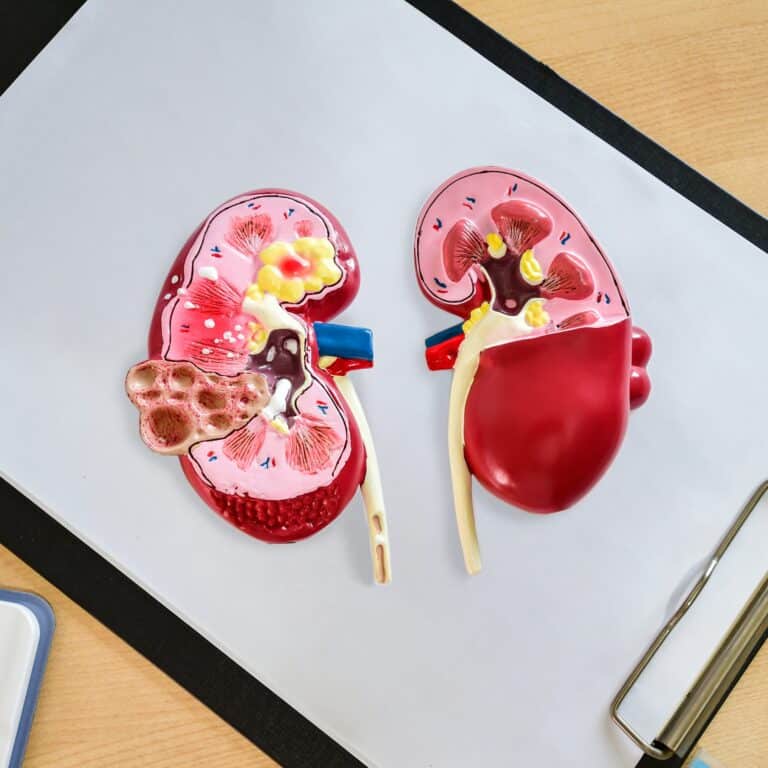How Can Yoga Help My CKD?
Exercise is important for everyone, but especially so for chronic kidney disease (CKD) patients. In order to keep your body healthy and your kidneys working to the best of their abilities, you must include regular exercise into your daily routine.
Yoga is increasing in popularity to control CKD. Its benefits have been known to help curb a lot of issues related to this long-term diagnosis.

According to the National Institutes of Health website:
“Yoga is a mind and body practice with historical origins in ancient Indian philosophy. Like other meditative movement practices used for health purposes, various styles of yoga typically combine physical postures, breathing techniques, and relaxation or meditation techniques.”
Many people, healthy and with ailments, use yoga to improve their health, wellbeing, and physical fitness. They may also practice yoga to help maintain specific conditions like anxiety or neck or back pain.
Studies have shown that CKD patients that practice yoga have a better chance of improving vital functions of their kidneys than those that only use conventional treatments. For most, it is seen as a safe therapy to reducing the effects or the disease, and may help to improve your quality of life while you deal with CKD.
In this article, we'll discuss how yoga can help your CKD in detail. We'll talk about different types of yoga practices, the role of yoga for kidney health, and even provide some tips on getting started so you can start feeling your best today.
Jump to:
- Benefits Of Yoga For CKD Patients
- Types Of Yoga To Consider
- Guidelines For Practicing Yoga With CKD
- Modifications For Different Stages Of CKD
- Special Considerations For Yoga With CKD
- Different Poses To Try
- Aiming For Balance And Moderation
- Combining Meditation And Visualization
- Other Alternative Therapies
- FAQs Yoga & CDK
- Yoga Is Very Beneficial For Kidney Patients
Benefits Of Yoga For CKD Patients
Yoga is becoming increasingly popular among those suffering from CKD. Practicing yoga can help CKD patients improve their physical and mental health. With the right guidance, a custom tailored practice of yoga postures and breathing techniques can be incredibly beneficial to anyone with CKD.
All of this is important in taking steps to improving kidney health.
Physical benefits of yoga for people with CKD include improved balance, strength, flexibility, coordination, posture and blood circulation. By incorporating restorative poses into your routine, you may also experience an increase in energy levels as well as a decrease in fatigue associated with the condition. Not only does this benefit your body but it can also have positive effects on your mind too.
The positive mental impact of yoga on CKD patients should also not be underestimated. Through regular practice, symptoms associated with depression such as low moods or feelings of sadness can be greatly reduced; allowing participants to remain calm even when faced with difficult situations related to their diagnosis.
Additionally, relaxation practices like meditation and mindfulness can create an inner sense of peace that helps alleviate stress caused by day-to-day life as well as anxiety around medical appointments or treatments.
The combination of physical and mental components found within a yoga practice makes it one of the most effective forms of exercise for those living with CKD.
It provides both the opportunity to work out while creating space for self-care which further encourages healing and overall well being on every level - body and mind alike!

Types Of Yoga To Consider
Yoga is like a breath of fresh air for those suffering from CKD. There are several different types of yoga available, each offering its own unique benefits. Hatha yoga emphasizes postures and breathing techniques to promote physical health and mental well-being while Vinyasa flow focuses on the connection between movement and breath.
Restorative yoga helps to relax the body through supported poses and can help reduce stress levels associated with CKD. Kundalini Yoga employs meditation, pranayama (breath work), mantra chanting, asanas (postures) and other spiritual practices in order to unlock energy stored within the chakras or ‘energy centers’ of the body.
Finally, Yin Yoga encourages deep stretching that works at a more gentle level than traditional forms of yoga by focusing on holding postures for longer periods of time rather than building strength quickly.
No matter which type of yoga you choose, all of them have been proven to be beneficial for people living with CKD. Each offers something specifically tailored to meet individual needs whether it's increasing flexibility, improving balance and coordination, or simply reducing stress levels.
With regular practice, any one of these types could make an enormous difference in your overall quality of life. So if you're looking for ways to ease into exercise without putting too much strain on your kidneys then exploring one or more types of yoga might just be your best bet!
For More Recipes and Ideas --->> Get Your Free Meals and Recipes That Are Perfect for Pre-Dialysis Diets, Pre-Dialysis with Diabetes, or Dialysis Diets.
Guidelines For Practicing Yoga With CKD
Now that you know what types of yoga may be best for your CKD, it’s important to understand the guidelines that will ensure safe and effective practice. First and foremost, those with CKD should always consult a doctor before beginning any type of exercise program, including yoga.
You want to make sure that it is safe for you to participate in physical activity without putting additional stress on your body or worsening symptoms.
When selecting a yoga class or instructor, look for someone who can provide modifications based on your individual needs - this could include using props such as blocks or straps to modify poses so they are more comfortable and accessible. Be sure to communicate any special health concerns or limitations directly with the teacher before starting a class.
It's also important to pay attention to how your body feels during and after practicing yoga. If at any time you feel lightheaded, dizzy, shortness of breath, fatigue or pain then stop immediately and rest until these sensations subside.
Additionally, if you have swelling in certain parts of your body (e.g., ankles), as is common in kidney patients, take extra care when doing stretches involving those areas because they might cause further discomfort. Your primary goal should be to gain greater flexibility while avoiding injury or overexertion.
Finally, remember that there is no one-size-fits-all approach when it comes to safely practicing yoga with CKD; you must consider all safety factors involved in order to get the most out of each session without aggravating underlying health conditions.
With careful consideration of medical advice combined with an awareness of one's own abilities and limits, individuals living with CKD can reap many benefits from regular yoga practice! Exercise for CKD Patients can be a really good thing!
Modifications For Different Stages Of CKD
Yoga is a beneficial exercise for those living with CKD. Adapting and modifying poses can help people at all stages of CKD to reap the maximum benefits from their practice. Keep in mind that there are exercise mistakes to avoid with ckd.
Here are four ways to modify yoga poses depending on which stage of CKD you're in:
- Stage 1-2: Focus on gentle stretches, low impact movements, and calming breathing exercises. If your energy levels allow it, try walking or swimming for extra cardiovascular activity.
- Stage 3-4: Strengthening postures should be done slowly and carefully - always listening to your body's cues. Pay attention to how quickly you tire out; if you experience fatigue more easily than usual, take rest breaks between poses as needed. Additionally, consider using props such as blocks or straps to assist with balance and stability during extended holds.
- Stage 5: In this advanced stage of CKD, focus on restorative yoga practices that emphasize relaxation and breath awareness above anything else. Seated meditation may also be helpful for bringing down stress levels while improving mental clarity - both of which can benefit overall well-being immensely!
- Dialysis Patients (End Stage Renal Disease): For those undergoing dialysis treatments, gentle stretching helps reduce stiffness and pain associated with these treatments. Incorporating deep breathing techniques into practice will also help alleviate any discomfort or anxiety related to dialysis sessions.
No matter where you’re at in your journey with kidney disease – there are modifications available so that everybody can enjoy the healing positive impact of yoga!
With careful consideration for each individual’s needs and limitations, practitioners have the opportunity to create an accessible practice tailored specifically for them – one that brings peace of mind along with physical relief from symptoms often associated with CKD.

Special Considerations For Yoga With CKD
Yoga can help those with CKD, but there are certain contraindications to consider before beginning a yoga practice. It is important for those with CKD to understand the benefits and risks of doing ckd-related yoga so they can make an informed decision about whether it’s right for them.
The first thing to be aware of is that poses involving inversions should be avoided due to their potential to increase blood pressure instability. This includes poses like headstands, handstands, and shoulder stands.
Additionally, any pose which causes shortness of breath or rapid breathing should also be avoided as this could reduce oxygen levels in the body and cause further health complications.
Next, it's essential to pay attention when practicing standing poses such as Warrior II or Triangle Pose. Balance can be impaired by the muscle weakness associated with CKD so modifications need to be made accordingly.
For example, using blocks or a chair for balance assistance may be necessary depending on how comfortable someone feels during these postures.
Finally, restorative poses are often recommended as part of a Yoga practice because they provide relaxation and stress relief without putting too much strain on the body. They allow practitioners to recharge while still getting all the benefits of traditional yoga including improved flexibility and strength.
With careful consideration given to possible contraindications associated with CKD however, individuals living with CKD should feel confident that they can engage safely in a regular Yoga practice if done mindfully and within individual limits.
Different Poses To Try
CKD patients can benefit from yoga postural exercises, breathing practices, relaxation techniques, and physical benefits. Yoga poses are known to help with improving circulation and increasing flexibility in the body.
This helps CKD patients as it increases oxygen flow throughout their body and strengthens muscles that have weakened due to their condition. Additionally, there are specific postures designed for those with kidney disease that can be beneficial for them. These poses include forward bends, twists, seated positions, and other more gentle movements.
Breathing exercises are also important when dealing with CKD because they allow patients to control the rate of their breathing while focusing on mental clarity. Breathing exercises can reduce stress levels and increase overall wellbeing by allowing one to connect deeply within themselves and become mindful of how they feel physically and emotionally.
Relaxation techniques such as guided meditation or progressive muscle relaxation (PMR) can further assist individuals in achieving a state of calmness which can help lower systolic and diastolic blood pressure levels associated with CKD.
Finally, practicing yoga has many physical benefits related to CKD including improved balance, increased strength in the core area, better posture, and greater mobility in joints.
Furthermore, regular practice may lead to an improvement in overall quality of life since it reduces fatigue and pain often experienced by people living with chronic conditions like this one.
With all these potential benefits available through yoga practice, it’s no wonder why so many CKD patients now turn towards this ancient form of exercise for relief from symptoms associated with their condition.
Aiming For Balance And Moderation
Yoga is a great way to help manage CKD. It can be used in conjunction with diet and hydration management as well as exercise to maximize quality of life. Aiming for balance and moderation when it comes to CKD will help ensure long-term health outcomes.
| Benefit | How Yoga Helps |
| Improved Renal Function | Studies have shown that Yoga improves renal function by causing a reduction in blood urea and serum creatinine levels and improving quality of life score for renal patients. |
| Lowering Blood Pressure | Yoga involves meditation, which helps to calm your body and improve blood supply. Yoga has been found to lower both diastolic and systolic blood pressures. This can be a huge benefit for CKD, because the condition and hypertension often go hand-in-hand. |
| Reducing Stress and Depression | The relaxation techniques in yoga have proven stress reduction benefits, helping you clear your mind and create a more positive outlook on life. While it’s common for CKD patients to experience depression, especially after diagnosis, performing yoga can help to develop coping skills and lower the negative thoughts and feelings. |
| Decreasing Water Retention | Many CKD patients have issues with swelling and fluid retention, especially as the condition advances and the kidneys are unable to effectively rid the body of water wastes. Yoga helps to get your body moving, reducing the water being stored in your body. For some patients, yoga could even reduce the amount of dialysis needed! |
| Enhanced Immune System | It’s common for CKD patients to be more susceptible to illness. This is because their immune system is compromised, with the level of toxins left in the body since the kidneys aren’t working effectively. With yoga, you can fight to improve immunity against these wastes, helping to flush them out so your kidneys don’t have to work as hard. Yoga has also been found to help with oxidative stress through increasing antioxidant activity. |
| Lowering Blood Sugar Levels | When you practice yoga poses, you are increasing the amount of glucose used by your muscles. This, in turn, helps to keep your blood glucose levels low. This is why yoga is so great for diabetics, which is a common cause for impaired kidney function and CKD. |
When we talk about aiming for balance and moderation, this means maintaining a healthy lifestyle through small changes that are sustainable over time. For example, by incorporating yoga into your daily routine you can reduce psychological stress levels, increase flexibility and strength, improve overall well being, promote better digestion, support healthier habits and more on your kidney healthy diet plan.
This type of holistic approach helps ensure long-term health benefits while also providing an enjoyable experience.
Overall, integrating yoga therapy into your daily routine is an excellent way to achieve balance and calmness in managing CKD symptoms.
Not only does it provide numerous physical benefits such as increased flexibility and improved digestion; it also helps reduce stress levels which may aid in preventing further damage from occurring within the kidneys.
The key here is consistency – if done regularly with proper form, yoga can offer amazing rewards that last far beyond just one session!
Combining Meditation And Visualization
Combining meditation and visualization can be a powerful tool for those with CKD. Visualization techniques are utilized to help people focus their attention on calming images or positive affirmations.
Meditating can bring about relaxation, improved health, better sleep quality, and an overall feeling of well-being.
Here are three reasons why combining these two activities is beneficial:
- Meditation-Visualization – By combining mind-body interventions through meditation and visualizing pleasant scenes or goals, one can reduce stress levels, which in turn helps improve CKD symptoms like fatigue and insomnia.
- Visualization-Techniques – Visualizing specific outcomes during meditation has been shown to increase motivation and success rates. Through practice, one can learn how to visualize more effectively by incorporating color, sound and other senses into their mental imagery.
- Meditation-Relaxation – Relaxing the body before meditating allows for deeper states of awareness where visualization techniques become most effective. This also helps alleviate physical discomfort associated with CKD such as pain and breathlessness.
The combination of meditation with visualization offers many benefits for improving renal dysfunction symptoms; from reducing stress levels to increasing motivation towards achieving personal goals.
Engaging in these practices regularly will create lasting changes that support health and wellbeing over time.
Other Alternative Therapies
Alternative therapies have been gaining popularity for treating CKD. Aside from yoga, there are a number of other alternative therapies that can help improve your CKD. Acupuncture is one such therapy which stimulates certain points in the body to alleviate pain and promote healing.
It also helps to reduce stress, anxiety symptoms, and depressive symptoms associated with CKD patients. Massage therapy is another popular treatment option as it relaxes muscles and improves circulation.
Hydrotherapy involves soaking in warm water which has therapeutic effects on muscle tension, joint stiffness, or any chronic pain experienced by those suffering from CKD.
Aromatherapy may be used to uplift moods and provide relief from physical symptoms related to kidney disease through the use of essential oils like lavender, peppermint, eucalyptus, etc.,
Lastly, reflexology can be beneficial for people affected by CKD as it works on specific pressure points in the feet and hands to unblock energy flow throughout the body to reduce inflammation and boost immunity.
These therapies all offer potential benefits for individuals living with CKD but should always be discussed with a healthcare professional before being used as treatments.
With these resources available at our disposal we now have more options than ever when it comes to managing our health conditions. There's no need to suffer alone - take charge of your recovery today!
FAQs Yoga & CDK
Yoga is often viewed as an effective intervention to improve physical strength and flexibility. Those with CKD may find it especially beneficial for them.
Practicing yoga can help CKD patients manage their symptoms and reduce the frequency of hospital visits. But how often should someone practice yoga when they have CKD?
When practicing yoga with CKD, consistency is key. A regular yoga practice will provide long-term benefits such as improved balance and coordination that are essential for daily living activities. It also helps maintain mental clarity while being mindful of body sensations and movements on the mat or chair.
The frequency at which a person practices varies depending on individual needs; however, starting off slow by committing to two or three times per week is ideal in order to prevent fatigue and overworking the muscles too soon.
The type of yoga practiced also matters when considering its potential therapeutic effect on CKD patients’ health conditions. Gentle hatha yoga poses tend to be more suitable since these do not require extreme movement or agility like some other styles of yoga do.
Simple yoga poses from this style focus on connecting breathwork with simple flowing movements to help ease tension in joints and build core muscle strength gradually over time.
On top of hatha yoga, restorative postures that involve relaxation techniques such as deep breathing exercises are recommended for reducing stress levels associated with having a serious medical condition like CKD.
Including CKD specific modifications into each pose during one's practice makes all the difference in terms of achieving greater success with managing symptoms caused by this chronic disease. Whether you have early stage kidney disease or are dealing with a stage 3 or 4, these tips are very helpful.
For instance, certain poses might need slight adjustments if there’s any pain experienced in particular areas due to weakened bones or joint inflammation—allowing enough room for self-compassion within the yogic experience adds an extra layer of healing that aligns well with overall wellbeing goals despite limitations imposed by having chronic kidney disease.
It's important to remember that everyone's journey with yoga looks different — no matter what condition they're dealing with — but making sure you start out slow and gentle will ensure your body feels supported throughout your practice without putting too much strain on it right away.
With continued dedication towards honing your craft, you'll definitely reap all sorts of rewards from doing CKD-specific yoga!
When it comes to CKD, yoga exercises can be a great way to manage symptoms and improve quality of life. But is it safe for CKD patients? The answer is yes! Yoga can be very beneficial and safe when practiced with caution.
The physical movements associated with yoga increase flexibility, strength, balance, coordination, range of motion and posture – all helpful components for managing CKD symptoms such as fatigue or joint pain.
When done correctly under proper supervision by a qualified instructor who understands your particular needs, you'll be able to reap the benefits without putting yourself at risk of injury or complications while practicing yoga safely.
It's important to remember that what works for one may not work for another. To ensure maximum benefit and safety when using yoga to help manage CKD symptoms, talk to your physician about any potential risks before starting a yoga intervention program tailored specifically for your individual needs.
With proper guidance and instruction from an experienced professional, you can enjoy the many health-promoting benefits of this ancient practice safely and confidently.
Practicing yoga is like taking a journey. It requires commitment, dedication and an investment of time to experience the full benefits that it has to offer. When considering how much time you should spend practicing yoga for your CKD, there are several factors to consider before embarking on this journey.
The amount of time needed for each person varies greatly depending upon their individual level of flexibility, strength and overall wellness goals. Generally speaking, those with CKD need to take extra care when selecting poses and practice duration due to their condition - but the good news is that even just 15 minutes per day can make a difference in managing symptoms.
The key is finding the right balance between intensity and frequency; while long 2-3 hour sessions may be too intense for someone suffering from CKD, shorter 10-15 minute sessions can provide relief without putting too much strain on the body.
If practiced regularly on a daily basis over a period of weeks or months, yoga can help create lasting changes in health outcomes such as improved sleep quality, better digestion and reduced stress levels – all beneficial effects for people with CKD.
It’s important to remember that everyone's needs are different so ultimately it comes down to personal preference regarding how much time you want to commit towards your practice.
Finding what works best for you will require some trial and error until you find something that fits into your lifestyle comfortably yet still provides great results - it might mean setting aside 30 minutes instead of one long session every Sunday afternoon! Also, pay attention to progression of symptoms for CKD.
Whatever it looks like for you, having realistic expectations about the amount of effort required to reap the rewards of yoga is essential in order to achieve optimal wellbeing through this form of exercise.
When practicing yoga with CKD, it's important to pay attention to special precautions. You should be aware of the potential risks and make sure that you're taking steps to practice safely, even if your CKD is in its early stages. Here are some considerations for doing yoga while managing CKD:
Start slowly. If you've never done yoga before or haven't practiced recently, it may be helpful to spend some time getting used to basic poses and movements first. Take breaks when needed and don't push yourself too hard.
Listen to your body. Yoga can help reduce stress, but overdoing it could lead to injury or aggravate existing health conditions. Pay attention to how your body feels during each pose and adjust accordingly so you don't overexert yourself.
Talk to a doctor about modifications. Some poses may not be appropriate for someone with CKD due to increased risk of falls or other complications from certain body postures. It's best to consult with a physician who is familiar with both yoga and CKD before attempting any new poses or techniques.
Yoga has become increasingly popular as a way of improving overall physical and mental well-being, but people with chronic illnesses need additional care when pursuing this type of exercise regime.
People living with kidney disease must take extra caution when engaging in activities such as yoga, since their condition increases the likelihood of injury or exacerbation of illness symptoms if they overexert themselves or attempt poses without proper safety measures in place.
It’s possible - even recommended - for people with CKD to benefit from regular exercise; however, they should always discuss safe alternatives with their healthcare provider prior to beginning any physical activity program in patients suffering from kidney disease.
Taking these simple precautions ensures that individuals get the most out of their yoga practice while protecting them from undue harm due to their medical condition.
Yoga Is Very Beneficial For Kidney Patients
It's clear that yoga can be a great way for those with CKD to stay healthy and active. With its many benefits, it's easy to see why so many people are turning to this ancient practice as a way of managing their CKD. Make sure you're also reading nutrition facts labels with CKD as well as using yoga as a tool.
That said, if done correctly, I'm confident that practicing yoga with CKD can have huge rewards. It not only helps manage physical symptoms but also brings about mental clarity and balance which is vital when dealing with any kind of illness.
So whether you're looking for more flexibility or simply want to reduce stress levels, give yoga a try! You won't regret it!
But above all else, don't forget safety first! Talk to your doctor before starting any new exercise routine and listen carefully to their advice - after all they know best! And finally, remember that everybody is different, so find what works for YOU and enjoy the journey!













I understand you all can e-mail me a booklet of 25 low impact exercises that are great for me with chronic kidney disease. Are there any exercises that can increase kidney function? Not just exercises to do? And is there anything out there that you can take to regenerate the kidneys? Thank you, so much in advance! Sue 🙂